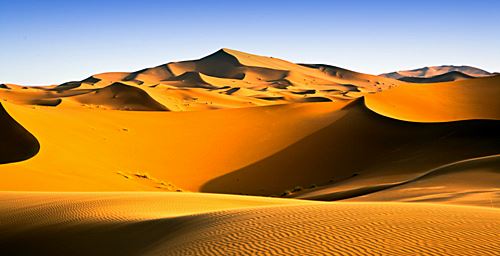
The warm desert climate is located in areas near
the Tropics of Cancer and Capricorn.
Precipitations - The annual
precipitations are very scarce. They do not usually reach the 150 mm annual and
in the steppes or semiarid edges of the desert they fall between 750 and 150 mm.
TEMPERATURE
It is located in areas close to the Tropics of Cancer and those of Capricorn. It covers a large part of Africa with the Sahara desert, which is the largest on the planet. It is also found in other regions such as: Australia, Arizona, Northern Mexico, South America and part of Central Asia.

FOOD CHAIN
CURIOSITIES
The temperature
are very hight. The annual average exceeds 18ºC and there are strong and wide thermal contrasts between day and night. In most of the world's deserts, daytime temperatures reach 40 or 50ºC, although in the Sahara they can reach up to 57ºC. At night, the temperature drops to 0 or -10ºC
FAUNA
The fauna is scarce but it is very well adapted to the environment in which it lives. Some characteristic animals are: snakes, chameleons, scorpions, tarantulas, vultures, crows, roadrunners, turtles, coyotes, kangaroos, camels and dromedaries.
The Flora is very little. The vegetation is sparse and adapts to dryness. Predominate xerophilous species, cacti and bushes. They have large roots, to take advantage of water from large amounts of land. They store water inside and transform the leaves into thorns to prevent evaporation. They also adopt a ball shape to protect themselves from the winds that carry sand.
WHERE IS LOCATED
FAUNA
The fauna is scarce but it is very well adapted to the environment in which it lives. Some characteristic animals are: snakes, chameleons, scorpions, tarantulas, vultures, crows, roadrunners, turtles, coyotes, kangaroos, camels and dromedaries.
FLORA
WHERE IS LOCATED
It is located in areas close to the Tropics of Cancer and those of Capricorn. It covers a large part of Africa with the Sahara desert, which is the largest on the planet. It is also found in other regions such as: Australia, Arizona, Northern Mexico, South America and part of Central Asia.

The fox eats the mouse, the
mouse eats the bird, the bird eats the plants. Decomposers (fungi and bacteria) eat
dead animals and plants.
CURIOSITIES
- 0,5 cubic millimeters was the average meteorological precipitation of Quillagua, in the Atacama desert (Chile), between 1964 and 2001.
- 16% is the proportion of the world population that lives in desert regions.
- 40 years can pass without a drop of water falling in these regions.
- 50 meters is the depth reached by the roots of the Saharan acacia to find water.
- 6ºC is the maximum thermal oscillation between day and night in the Sahara desert.
- 200 liters is the volume of water that a camel can drink in a quarter of an hour.
- 300 years can wait to germinate some seeds of Saharan plants.
- 600 kilometers is the length that the roots of some desert shrubs reach to find water.
- 8.000 liters is the amount of water that the giant saguaro cactus can store to survive during more than 2 years of drought.
THE INTERACTION BETWEEN HUMANS AND THE WARM DESERT
Positive
It is far from the urban centers.
It covers all climate varieties.
Negative
The summers are very hot and the winters are very raw.
Some people who live there treat animals badly.




It´s very well
ResponderEliminar